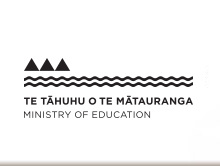Kia Tūpato Marama!
nā Rona Lawson
He Whakarāpopototanga
Ka tākaro hītokotoko a Marama, he kaha ōna hoa ki te akiaki i a ia kia oti pai ai.
Summary
Marama is playing hopscotch, her friends are very encouraging while she is playing.
| Te momo reo tuhi Language style |
|
|---|---|
| Ētahi āhuatanga o tēnei momo reo tuhi Features of this language style |
|
I te Ākonga e Pānui Ana
During Reading
Titiro ki te uhi o mua:
1. Kei hea a Marama?
2. Kei te aha a Marama?
3. Pānuitia te taitara, ki ōu whakaaro he aha ngā kaupapa kei roto tonu i te pukapuka?
Look at the cover of the book:
1. Where is Marama?
2. What is Marama doing?
3. Read the title, what do the you think will happen in the book?
Titiro ki ngā whārangi 2 me 3:
1. He aha te mahi a ngā tamariki i ngā whakaahua nei?
2. He aha ngā mea kei ō rātau ringaringa?
3. Ki ōu whakaaro, ko tēhea wā o te rā tēnei?
4. Ka pēhea koe e mōhio ai?
Look at pages 2 and 3:
1. What are the children doing in these pictures?
2. What do they have in their hands?
3. What time of the day could this be?
4. How do you know this?
Titiro ki ngā whārangi 4 me 5:
1. He aha te mahi a Marama i ngā whakaahua?
2. He aha te otinga mēnā kāore e taea e Marama te peke tawhiti?
Look at pages 4 and 5:
1. What is Marama doing in these pictures?
2. What might happen if Marama is unable to jump the distance?
Titiro ki ngā whārangi 6 me 7:
1. Ki ōu whakaaro, ka oti pai i a Marama tana kēmu hītokotoko?
2. He aha koe i whakaaro pēnā ai?
Look at pages 6 and 7:
1. Do you think Marama will finish her hopscotch game successfully?
2. What makes you think so?
Titiro ki te whārangi 8:
1. Kua tika ōu whakaaro? I oti pēhea nei i a Marama tana kēmu?
2. He tīwhiri anō i te whakaahua hei tautoko i tō matapae?
Look at page 8:
1. Were you right? How did Marama finish her game?
2. Is there a clue in the picture that helped you come to that conclusion?
I Muri i te Pānui Pukapuka
After Reading
Te Whakahihiko Hinengaro
He ngohe ēnei e pā ana ki ngā kōrero i roto i ngā pukapuka katoa, arā, Ko Wai te Toa?, Kia Tūpato Marama!, Poutoti, me Ōku Ringaringa. Ka taea e te pouako ēnei te whakamahi kia tutuki ngā whāinga whakaako me ngā whāinga ako. Mā te pouako ēnei ngohe e whakahāngai ki ngā whāinga ako me ngā hiahia o ngā ākonga.
Ia rā waiatahia te waiata Te Arapū Māori. Hoatu he kāri arapū ki ngā tamariki, mā rātou e whakaraupapa ā-arapū mai. Hei āwhina, ka whai pea i te raupapa o tētahi arapū kua tuhia ki te papatuhituhi, kua whakairihia rānei ki te pakitara.
Prompting Ideas
These are some ideas for learning which may be used in connection with the books Ko Wai te Toa?, Kia Tūpato Marama!, Poutoti, and Ōku Ringaringa, that pouako can use to help achieve their teaching purposes. These ideas can be adapted as required to suit the learning objectives and needs of the students.
Practise the song Te Arapū Māori. Give the students a set of alphabet cards to sort into alphabetical order. To help them, they could follow the alphabet written on the board or have an alphabet frieze on the wall.
Anei ētahi mahi hei āwhina i ngā ākonga kia mārama ai ki ngā ariā o te pukapuka.
1. Tukuna ngā ākonga kia tākaro hītokotoko, engari me whakamahi e rātau ngā kupu reo raupapa. Mā ngā ākonga tonu te ingoa tonu o te hoa tākaro e whakamahi, arā, "Kia rite ... "
2. Tuhia te kōrero o te pukapuka ki runga kāri. Hoatu ngā kāri ki ngā ākonga. Ko tā rātau mahi, he whakaraupapa i ngā kāri kia tika ai te raupapa o te kōrero.
3. Tāruatia te kōrero me te pikitia ki runga kāri. Kutia, kia noho motuhake te kōrero me te whakaahua. Ko tā te ākonga mahi, he hono i te kōrero ki ngā whakaahua tika.
4. Tukuna ngā ākonga kia tāia he pikitia mō tētahi wāhanga o te pukapuka, kātahi ka kōrero mō taua pikitia. Mā te kaiako te kōrero a te ākonga e tuhi ki runga i tana pikitia.
Here are some activities which may help students learn the concepts in the book.
1. Allow students to play hopscotch, but they must use the sequencial words in the book. Each child will replace the name in the book with their friends when playing. For example, "Kia rite ... "
2. Write the text on cards. Give the cards to the students. Students will put the sentences in the order that they appear in the text.
3. Photocopy the text and pictures on to card. Cut these so that the text and pictures are separate. The students match up the correct text with the correct pictures.
4. Get students to draw a picture about a part of the book, and then talk about their picture. The teacher then writes what the student has said on his/her picture.






